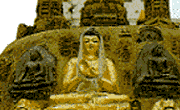


| 
| |
| HOME | TRAVEL | TRAVELOG | ||
 
Pitrapaksh Tarpan is the monsoon fortnight when Hindus flock to the small town of Gaya in north Bihar to pray for their dead and to bathe in the holy Phalgu river. According to the Vedas and Puranas, Gaya, like Varanasi, was sanctified by Lord Vishnu as a spot where devout Hindus could wash away their sins. Gaya is an interesting place to visit this month and our destination for the week. We inaugurated this series with an overview of Tranquebar, then offered the Orissa beach resort, Gopalpur-on-Sea, and the hill towns of Mirik and Kurseong, south of Darjeeling. We followed up with the historical Rajasthani town of Chittaurgarh, beautiful Sarahan in eastern Himachal, forgotten Orchha in Madhya Pradesh and lush green Chikhaldhara in eastern Maharashtra. Gaya
Over the centuries Buddhist pilgrims, from different lands, have erected shrines and sanctified this spot in their own chosen manner. The Peepul tree that stands nearby is said to be a 'relative' of the first. It is believed that Emperor Ashoka, the great Buddhist of the 3rd century BC, constructed the first temple here in Buddha's honour. Subsequently over the centuries the temple was broadened, redecorated expanded and beautified by the devout, including Burmese Buddhists. An avatar of Ashoka's shrine exists at the same spot. The elaborate temple houses a statue of a golden Buddha in meditation. The Japanese came along hundreds of years later and constructed an impressive Japanese temple, replete with marble floors and many gilded statues of the Lord, as well as a 60-foot tall statue of Buddha in stone. The Tibetan Buddhists -- The Dalai Lama is in residence here in December or January for a few weeks -- have their own corner; a monastery and a colourful Tibetan temple with its special wheel of law. And then there is the Bhutanese temple, the Nepali temple, the Thai temple, the Sri Lankan temple, the Vietnamese temple, the Chinese temple and the brand new Bangladesh temple, as well as monasteries run by different countries. Bodh Gaya has an unusual international flavour that makes a visit very worthwhile. Interestingly, Bodh Gaya attracts Hindu pilgrims who consider Buddha one of their own gods, an incarnation of Vishnu. Nearby at the Nipponji Temple complex free meditation opportunities and free medical aid is dispensed. The great Peace Bell hangs here. Magadha university, the ancient seat of Indian learning, is in the neighbourhood and still attracts hundreds of students. The main town of Gaya, 16 km away, has an atmosphere very different from this serene Buddhist pilgrimage spot. Gaya overflows with happy confusion. There are several old temples in the town, including Buddhist shrines. The beautiful Vishnupad temple is the most significant of Hindu places of worship, named thus as it was believed to have been erected over Vishnu's footprint. Brahmajuni Hill, nearby and 1,000 steps up, offers a wonderful view of Gaya and the surrounding countryside. Along the seasonal Phalgu river many pujas take place simultaneously. Pindas or rice savouries and sweets are offered in ceremonies honouring the dead, including long gone ancestors, to set their souls free. Cremations take place too at the burning ghats a little way up the river.
The Barabar caves, with their rock cut monasteries, 35 km from Gaya are also worthy of a visit. It is a tough trek. The caves provided inspiration for E M Forster's Marabar caves in A Passage to India.
The best time to visit Gaya is during late September or October for Pitrapaksh Tarpan or in the winter from November to early March.
It is probably advisable to stay at Bodh Gaya where better accommodation is available. Gaya too a few decent hotels. Winter is the touristy season in Bodh Gaya when plenty of pilgrims arrive and tariffs are double what they are in the slack season. During the slack season good food is difficult to obtain at Bodh Gaya.
Gaya is about two and a half hours from Patna. There is a regular bus service between Patna and Gaya. Gaya is 16 km from Bodh Gaya. It is possible to reach Bodh Gaya by autorickshaw or a cycle rickshaw. If you hire the entire auto and do not opt for a shared auto (a nightmare) expect to pay about Rs 100. It is not advisable to do the Bodh Gaya commute from Gaya after nightfall. A number of tourists have been robbed. The Rajdhani Express pulls into Gaya daily, except Thursdays and Sundays, from New Delhi and daily, except Wednesdays and Saturdays, from Calcutta. The Kalka-Howrah/Howrah-Kalka Mail pulls into Gaya daily. The nearest airport, Patna, is two-and-a-half hours away and Indian Airlines flies into Patna daily from New Delhi and Calcutta. | ||
|
| ||
INFOTECH | TRAVEL | LIFE/STYLE | FREEDOM | FEEDBACK |